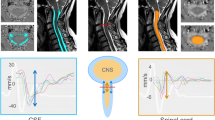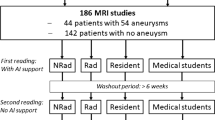Abstract
Introduction
The current study evaluated the signal characteristics of susceptibility weighted imaging (SWI) of arteriovenous malformation (AVM), especially for draining veins. For this purpose, we identified the draining veins of the AVM on angiography and evaluated the signal on magnitude image for SWI (SWI-mag) and minimum intensity projection image (SWI-minIP).
Methods
Subjects were 14 cases with angiographically proven AVM. SWI-mag, SWI-minIP, and time-of-flight (TOF) magnetic resonance angiography were acquired. For the draining veins of the AVM identified on angiography, we analyzed signal intensity on the images listed above, and classified it into hyperintensity (hyper), mixed intensity (mixed), hypointensity (hypo), and no visualization.
Results
On the analysis of 27 angiographically proven draining veins, 19 draining veins were classified as hyper, 3 as mixed, 0 as hypo, and 6 as no visualization on SWI-mag. On TOF images, 21 draining veins were classified as hyper, 2 as mixed, 0 as hypo, and 4 as no visualization, while 6 draining veins did not show hyperintensity on TOF, and SWI-mag visualized 3 of these 6 veins as hyper.
Conclusion
SWI-mag depicted most draining veins of AVM as hyperintensity. We speculate that this is mainly due to the higher concentration of oxygenated hemoglobin (oxy-Hb) and inflow effect of the draining vein. SWI-mag seems to be useful in the analysis and follow-up for AVM as the signal on the image may reflect physiological status.




Similar content being viewed by others
References
Ogilvy CS, Stieg PE, Awad I, Brown RD Jr, Kondziolka D, Rosenwasser R, Young WL, Hademenos G (2001) AHA Scientific Statement: recommendations for the management of intracranial arteriovenous malformations: a statement for healthcare professionals from a special writing group of the Stroke Council, American Stroke Association. Stroke 32(6):1458–1471
Yuki I, Kim RH, Duckwiler G, Jahan R, Tateshima S, Gonzalez N, Gorgulho A, Diaz JL, De Salles AA, Vinuela F (2010) Treatment of brain arteriovenous malformations with high-flow arteriovenous fistulas: risk and complications associated with endovascular embolization in multimodality treatment. Clinical article. J Neurosurg 113(4):715–722. doi:10.3171/2009.9.JNS081588
Haacke EM, Xu Y, Cheng YC, Reichenbach JR (2004) Susceptibility weighted imaging (SWI). Magn Reson Med 52(3):612–618. doi:10.1002/mrm.20198
Sehgal V, Delproposto Z, Haacke EM, Tong KA, Wycliffe N, Kido DK, Xu Y, Neelavalli J, Haddar D, Reichenbach JR (2005) Clinical applications of neuroimaging with susceptibility-weighted imaging. J Magn Reson Imaging 22(4):439–450. doi:10.1002/jmri.20404
Haacke EM, Mittal S, Wu Z, Neelavalli J, Cheng YC (2009) Susceptibility-weighted imaging: technical aspects and clinical applications, part 1. AJNR Am J Neuroradiol 30(1):19–30
Barnett GH, Little JR, Ebrahim ZY, Jones SC, Friel HT (1987) Cerebral circulation during arteriovenous malformation operation. Neurosurgery 20(6):836–842
George U, Jolappara M, Kesavadas C, Gupta AK (2010) Susceptibility-weighted imaging in the evaluation of brain arteriovenous malformations. Neurol India 58(4):608–614
Stapf C, Mast H, Sciacca RR, Berenstein A, Nelson PK, Gobin YP, Pile-Spellman J, Mohr JP (2003) The New York Islands AVM Study: design, study progress, and initial results. Stroke 34(5):e29–e33. doi:10.1161/01.STR.0000068784.36838.19
Al-Shahi R, Bhattacharya JJ, Currie DG, Papanastassiou V, Ritchie V, Roberts RC, Sellar RJ, Warlow CP (2003) Prospective, population-based detection of intracranial vascular malformations in adults: the Scottish Intracranial Vascular Malformation Study (SIVMS). Stroke 34(5):1163–1169. doi:10.1161/01.STR.0000069018.90456.C9
Stapf C, Labovitz DL, Sciacca RR, Mast H, Mohr JP, Sacco RL (2002) Incidence of adult brain arteriovenous malformation hemorrhage in a prospective population-based stroke survey. Cerebrovasc Dis 13(1):43–46
Starke RM, Komotar RJ, Hwang BY, Fischer LE, Garrett MC, Otten ML, Connolly ES (2009) Treatment guidelines for cerebral arteriovenous malformation microsurgery. Br J Neurosurg 23(4):376–386
Soderman M, Andersson T, Karlsson B, Wallace MC, Edner G (2003) Management of patients with brain arteriovenous malformations. Eur J Radiol 46(3):195–205
Starke RM, Komotar RJ, Hwang BY, Fischer LE, Otten ML, Merkow MB, Garrett MC, Isaacson SR, Connolly ES Jr (2008) A comprehensive review of radiosurgery for cerebral arteriovenous malformations: outcomes, predictive factors, and grading scales. Stereotact Funct Neurosurg 86(3):191–199
Geibprasert S, Pongpech S, Jiarakongmun P, Shroff MM, Armstrong DC, Krings T (2010) Radiologic assessment of brain arteriovenous malformations: what clinicians need to know. Radiographics 30(2):483–501
Gupta V, Chugh M, Walia BS, Vaishya S, Jha AN (2008) Use of CT angiography for anatomic localization of arteriovenous malformation Nidal components. AJNR Am J Neuroradiol 29(10):1837–1840
Tanaka H, Numaguchi Y, Konno S, Shrier DA, Shibata DK, Patel U (1997) Initial experience with helical CT and 3D reconstruction in therapeutic planning of cerebral AVMs: comparison with 3D time-of-flight MRA and digital subtraction angiography. J Comput Assist Tomogr 21(5):811–817
Tsuchiya K, Katase S, Yoshino A, Hachiya J (2000) MR digital subtraction angiography of cerebral arteriovenous malformations. AJNR Am J Neuroradiol 21(4):707–711
Divani AA, Lieber BB, Wakhloo AK, Gounis MJ, Hopkins LN (2001) Determination of blood flow velocity and transit time in cerebral arteriovenous malformation using microdroplet angiography. Ann Biomed Eng 29(2):135–144
Iwamura A, Taoka T, Fukusumi A, Sakamoto M, Miyasaka T, Ochi T, Akashi T, Okuchi K, Kichikawa K (2012) Diffuse vascular injury: convergent-type hemorrhage in the supratentorial white matter on susceptibility-weighted image in cases of severe traumatic brain damage. Neuroradiology. doi:10.1007/s00234-011-0892-9
Conflict of interest
We declare that we have no conflict of interest.
Author information
Authors and Affiliations
Corresponding author
Rights and permissions
About this article
Cite this article
Miyasaka, T., Taoka, T., Nakagawa, H. et al. Application of susceptibility weighted imaging (SWI) for evaluation of draining veins of arteriovenous malformation: utility of magnitude images. Neuroradiology 54, 1221–1227 (2012). https://doi.org/10.1007/s00234-012-1029-5
Received:
Accepted:
Published:
Issue Date:
DOI: https://doi.org/10.1007/s00234-012-1029-5




